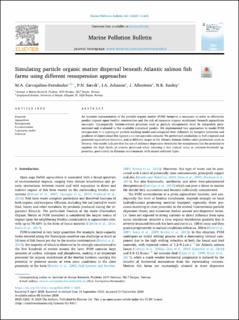Simulating particle organic matter dispersal beneath Atlantic salmon fish farms using different resuspension approaches
Carvajalino-Fernandez, Marcos Antonio; Sævik, Pål Næverlid; Johnsen, Ingrid Askeland; Albretsen, Jon; Keeley, Nigel B.
Journal article, Peer reviewed
Published version

Åpne
Permanent lenke
https://hdl.handle.net/11250/2739950Utgivelsesdato
2020-10-08Metadata
Vis full innførselSamlinger
- Geophysical Institute [1198]
- Registrations from Cristin [9791]
Originalversjon
Marine Pollution Bulletin. 2020, 161, Part B, 111685 10.1016/j.marpolbul.2020.111685Sammendrag
An accurate representation of the particle organic matter (POM) footprint is necessary in order to effectively predict impacts upon benthic communities and the risk of excessive organic enrichment beneath aquaculture sea-cages. Consequently, bottom-related processes such as particle resuspension must be adequately parametrized and evaluated in the available numerical models. We implemented two approaches to model POM resuspension in a Lagrangian particle tracking model and compared their influence on footprint extension and gradients of depositional flux against a no-resuspension scenario. We performed simulations in both exposed and protected aquaculture locations, and at different stages of the Atlantic Salmon (Salmo salar) production cycle in Norway. Our results indicate that the use of sediment-dependent thresholds for resuspension has the potential to regulate the high levels of erosion produced when selecting a low critical value in constant-threshold approaches, particularly in dynamic environments with mixed sediment types.
